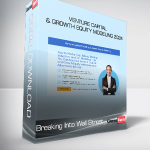Breaking Into Wall Street – Venture Capital & Growth Equity Modeling 2024
Original price was: $197.00.$89.00Current price is: $89.00.
Learn how to evaluate deal terms for startup investments, assess their valuations…
File Size: 6.68 GB.
- Description
- Reviews (0)
Description
Breaking Into Wall Street – Venture Capital & Growth Equity Modeling 2024

How to Master Cap Tables, Startup Valuation, and Exit Modeling – So You Can Ace Your Venture Capital and Growth Equity Interviews and Advance to the Top
Evaluate companies and deals like a pro
You’ll understand cap tables, startup/growth valuations, and exits
Master financial modeling
You’ll build forecasts and analyze metrics for tech and biotech startups
Complete 9 case studies
You’ll learn the numbers and how to make investment recommendations
Let’s cut to the chase: There are quite a few venture capital and growth equity courses on the market, but most of them miss the mark because they do not teach what you need to know for interviews and case studies.
Most “courses” use one of the following (wrong) approaches:
Wrong Approach #1: Heavy Focus on Term Sheets – It’s good to know about the common legal and control terms in deals, but no VC or growth equity fund will test you based on these; they care mostly about your ability to evaluate investments. If they wanted summaries of written documents, they could pay an overpriced lawyer or ask ChatGPT!
Wrong Approach #2: Generic 3-Statement Models and Valuations – The problem here is that these models are not specific to what you do in venture capital and growth equity. Sure, it’s good to know how to build a basic 3-statement model… but it doesn’t matter unless you know how to use it to make an investment recommendation.
The correct approach – the one our course uses – is based on real-life case studies given in interviews.
Before creating this course, we gathered dozens of case study examples from students and readers who had been through VC, GE, and related interviews, and we synthesized the best parts into the course materials.
The goal was to highlight the most important points while “trimming the fat.”
Our approach focuses on the 3 most important points in venture capital and growth equity interviews:
1) The Numbers – You need to know the cap table math and financial analysis around a company’s growth and potential exit, so each case study here covers that.
2) The Market – But it’s equally important to understand the market, including why a company’s product might succeed or fail, its pricing and potential sales, and how it differentiates itself from competitors.
3) The Recommendation – Finally, you need to understand how to put together all the pieces to make an investment recommendation. You must be able to look at a company and its financial, product, and market information and say “Yes” or “No.”
No other training on the market puts together all the pieces quite like this because they focus on endless definitions and explanations of term sheets (yawn…) or generic models that could apply to virtually any finance job (you can get these for free in our YouTube channel!).
Everyone is pressed for time and distracted by endless content these days, so we focused on making this course accessible as well.
That means there are study plans for as little as 2-4 hours, but if you want to go into more depth, there are also 10-hour and 20-hour options available.
Think of it as a “Choose your own adventure,” but each door is a different case study, and the grand prize is a job offer at the VC or growth equity firm you’re most interested in.
The course is divided into 5 short case studies (think: weekend crash-course plan) and 4 longer case studies (think: on-the-job mastery).
Through these case studies, you’ll learn to:
- Analyze a startup’s market and customers, including cohort analysis for Software as a Service (SaaS) companies.
- Build capitalization tables (cap tables) for Seed and Series A – C funding rounds.
- Model the impact of liquidation preferences, employee option pools, participating preferred (capped and uncapped), and more.
- Discern if a startup’s financial forecasts are credible or closer to a fantasy novel.
- Understand how “down rounds” and terms like anti-dilution and pay-to-play affect exits and investment results.
- Value tech and biotech companies based on multiples and the DCF, with adjustments for “key person” risk, illiquidity, and more.
- Explain how biotech and tech startups differ and how that translates into valuation, cap table, and exit differences.
- Evaluate different deal structures, such as SAFE Notes vs. priced equity rounds, and the trade-offs between valuations and downside protection for the investors.
- Value biotech startups with a Sum-of-the-Parts DCF that analyzes each drug’s potential separately.
- Build advanced cap tables with support for features such as convertible notes, venture debt, pro-rata equity, anti-dilution provisions, participating preferred, and pari passu vs. ranked seniority.
- Make investment recommendations based on everything above, factoring the qualitative and quantitative factors.
If you want to answer interview questions and case studies with ease and leap up the ladder once you start working, this is the course for you.
![]()
Brian DeChesare
Founder, Breaking Into Wall Street
Here’s What You’ll Get When You Sign Up for This Venture Capital & Growth Equity Modeling Course:

Seed, Series A, and Series B Case Studies

WHY IT’S IMPORTANT: This training gets you up to speed quickly with startup evaluation, cap tables, and investment recommendations for startups.
You’ll complete 3 short case studies based on companies raising Seed, Series A, and Series B funding rounds in this introductory training
Through these case studies, you’ll learn how to evaluate deal terms for startup investments, assess their valuations, and determine if VC investors could plausibly earn their targeted returns.
You’ll also learn how to model priced equity rounds, employee options pools, SAFEs, liquidation preferences, participating preferred, anti-dilution provisions, and more.
This module is designed to be a “weekend crash course,” so you quickly can learn the most important points without getting bogged down in minutiae.

Series C and D Case Studies

WHY IT’S IMPORTANT: This module gets you up to speed with biotech valuation, SaaS modeling, and the terms in late-stage VC and growth deals.
The first case study here is based on a simple biotech valuation and explains the differences in forecasting biotech cash flows – plus cap table terms such as “pari passu” seniority for certain investor groups.
The second case study is based on a growth equity round for a software startup; you’ll learn how to forecast revenue and expenses linked to individual customers, calculate the returns, make an investment recommendation, and complete a cohort analysis.

Startup and SaaS Financial Modeling and Valuation

WHY IT’S IMPORTANT: These lessons explain how to model and value a “small business” SaaS company based on a granular financial model with individual employees and customer contracts.
“Granular financial models” are the name of the game in venture capital and startups. If you can’t predict how much cash flow the company will generate in the next two quarters, how can you predict the amount of outside funding it might need to raise?
This case study walks you through the entire model, from revenue and expenses to the construction of “real” financial statements based on random and disorganized historical data (just like most startups in real life).
You’ll also learn to calculate and interpret key SaaS metrics, such as LTV / CAC, Gross and Net Retention, Payback Periods, and more.
The last few lessons cover private company valuation and all the adjustments and discounts you need to make in a DCF and valuation – and how these factor into your fundraising recommendations to the company.

Late-Stage Exit and Growth Equity Modeling

WHY IT’S IMPORTANT: This training explains how to model and value later-stage companies and recommend the best exit option (M&A vs. IPO vs. SPAC), considering all the investor groups.
In this case study, you’ll learn how the analysis and valuation of a later-stage tech company differ from an early-stage one.
You’ll also learn how to model exit scenarios such as an IPO, a SPAC, and an M&A deal with a significant Earnout component and recommend the best one for the company’s short-term and long-term goals.
The last few lessons walk you through this company’s cap table and a flow-of-funds analysis, so you can see how the exit options affect the different investor groups and make a recommendation based on that.

Advanced Cap Table Case Study

WHY IT’S IMPORTANT: This module gives you practice with building a “real world” cap table based on messy financings, a down round, and ambiguous conversion and exit terms.
These lessons walk you through an advanced capitalization table with support for features such as convertible notes and venture debt, in addition to liquidation preferences and participating preferred stock.
You’ll learn how to model the conversions to common shares, how anti-dilution affects all the investors, and how to properly deal with options and warrants in an exit (including the circularity inherent in these calculations).
Finally, you’ll learn about the lenders’ perspective on the deal by calculating the returns to the venture debt firm responsible for an earlier funding round.

Sum-of-the-Parts Biotech Valuation

WHY IT’S IMPORTANT: This case study walks you through a full valuation of Ventyx as it attempts to raise follow-on equity, including drug-by-drug analysis.
These lessons break down the Sum-of-the-Parts DCF and valuation for biotech firms, from market research to revenue and cash flow estimates.
You’ll learn how to value each pipeline drug, risk-adjust for the probability of success, and then combine everything into a single corporate-level DCF that factors in net operating losses (NOLs) and tax savings.
In the final lessons, you’ll use this model to make an investment recommendation and support your findings with a quick analysis of the public comps and precedent transactions.

Certification Quiz

WHY IT’S IMPORTANT: This end-of-course certification quiz lets you test your knowledge and prove it to employers.
This quiz consists of 25 challenging questions that are all based on the case studies in the course.
If you pass the quiz with a 90% score (no restrictions on time or the number of attempts), you’ll gain our Certificate in Venture Capital Modeling, which you can add to your LinkedIn profile and present in interviews.
What’s Your Investment In This Venture Capital & Growth Equity Modeling Course?
To put this in context, let’s look at your Return on Investment in this course…
The pay for entry-level venture capital and growth equity positions varies, but it’s safe to say that even entry-level Associates will earn at least $150,000 USD per year, if not more than that at larger VC/GE firms (perhaps up to $250,000+).
And as you progress, your total compensation gets higher and higher; Principals can earn into the mid-six-figure range, and Partners can earn $1+ million annually, depending on the fund size and overall performance.
And each one had to start in an entry-level role to get their foot in the door – just like you today.
We could sell the 7 core components of this course for $97 each, for a total of $679, but since this course is new, we’re offering an even better deal and discounting it to just $247.
Compared with your potential upside – jobs that pay well into the six-figure range – your investment in the course is nominal.
By investing just $247 in this course, you’re greatly improving your chances of landing a job that pays upwards of $150,000 in Year 1 – that’s more than a 600x return on investment!
Even if this training only helps you to win an internship, that’s still at least $10,000 USD at any reputable firm, for a 40x ROI.
There is no other way to get this level of training… this level of on-demand support… this level of testing and case study practice… and this level of access to a community of thousands of peers…
…at ANY price!
So yes, you have to invest in yourself to gain access to this specialized venture capital and growth equity training, but it will be one of the smartest, highest-return investments you ever make – we guarantee it!
We’ve bent over backward to deliver the best, most comprehensive program on the market that gives you everything you need to land a great job and start a long-term career in venture capital or growth equity.
To date, over 56,763+ people have invested in BIWS training and gone on to secure lucrative jobs in the industry. I want you to be next, and I want to make this a “no-brainer” decision for you.
Here’s What Will Happen Within a Few Short Moments of You Joining the Venture Capital & Growth Equity Modeling Course:
The minute you join, you’ll have access to the complete VC & Growth Equity Modeling course, including 117 separate videos, 141 pages of detailed written guides and interview questions, transcripts and subtitles/captions for all the videos, “Before and After” Excel files, and 9 case studies based on different startups and growth-stage firms in both tech and life sciences.
And the best part: We’ll be here to guide you every step of the way because your enrollment comes with a full 5 years of expert support. If there’s something you don’t understand, just go to the “Question/Comment” area below each lesson and ask your question, and we’ll respond with a detailed answer.
On top of that, you’ll also get access to free updates over time as we upgrade these courses and add new material.
Decision and Action Time
Of course, there are other options for learning this material.
For example, you could complete a course on this topic from another provider, buy a generic course on a random e-learning site for $10 or $20… or read a long book about venture capital deals.
These methods have their merits, but they won’t get you the same results as this course because they’re designed for “generalist” audiences – not people currently interviewing for investment roles at VC/GE firms.
So, if you want to master startup valuation, cap table modeling, exit modeling, and investment recommendations as they are used in these industries and hit the ground running on day 1 of your internship or full-time job, this training is your best option.
Yes, it is more of an investment than a book or an online course written by monkeys at the keyboard, but ask yourself about the value of your time and interview opportunities.
If you win a coveted interview spot at a top VC firm like Sequoia, NEA, or Accel, or at a top growth equity firm, like Summit or TA Associates, do you want to “wing it?”
Or do you want to ensure that you’ve prepared in the most comprehensive way possible?
If you’re serious about your future career in the finance industry, you should not even have to think about this one.
And if you have any doubts, it’s all backed by our no-questions-asked, no-hassle, 90-Day Money-Back Guarantee.
In fact, the ONLY risk is that you might apply for a job or walk into an interview without this course – and lose out to another candidate who has completed it.
The next move is up to you.
You can hope that an investment firm hires you without knowledge of these topics and the ability to complete case studies and make investment recommendations…
…or you can confidently tell them you’ve completed the most targeted VC, growth equity, and startup training available, based on 9 case studies and authored by finance professionals who have collectively worked on dozens of deals.
I know you’ll make the right choice.
To YOUR success,
![]()
Brian DeChesare
Breaking Into Wall Street Founder
Get Digital Download ” Breaking Into Wall Street – Venture Capital & Growth Equity Modeling 2024 ” Right Now!



Reviews
There are no reviews yet.